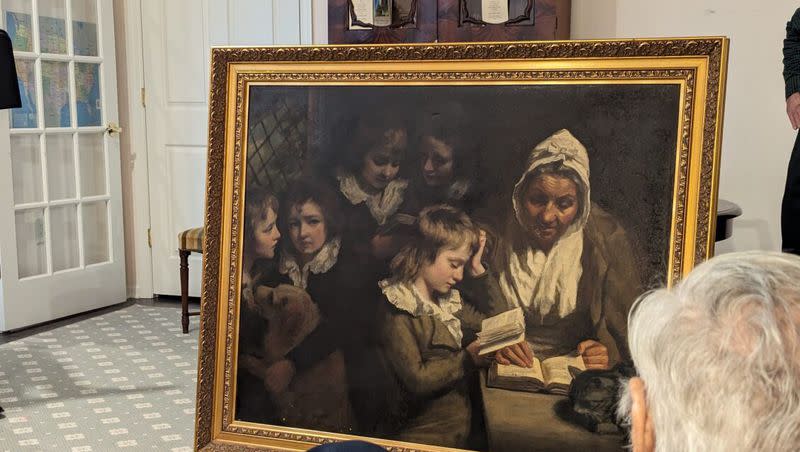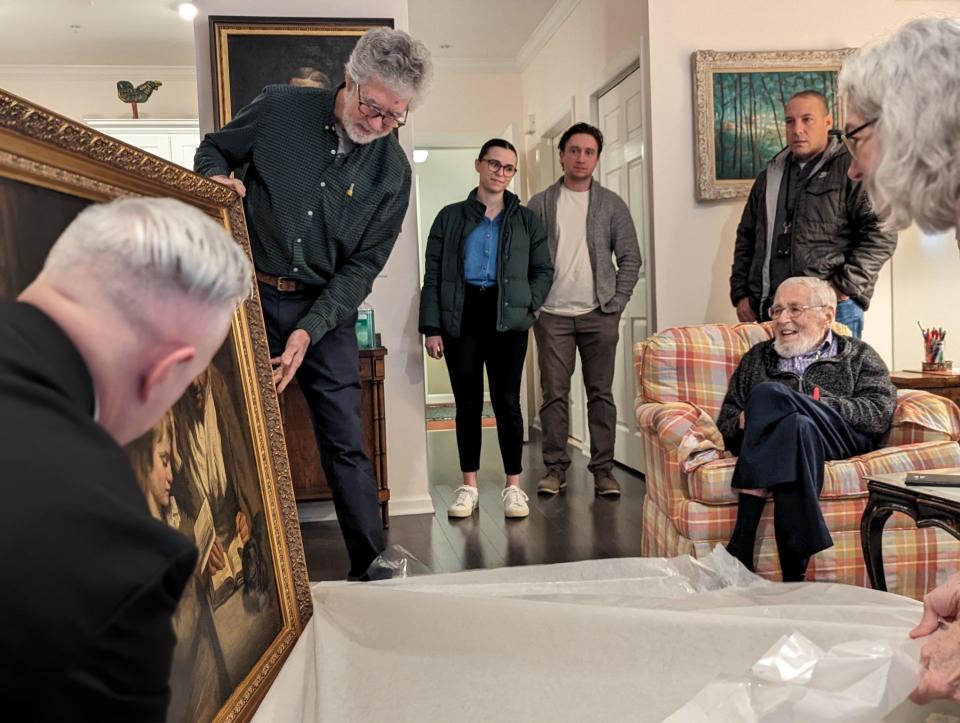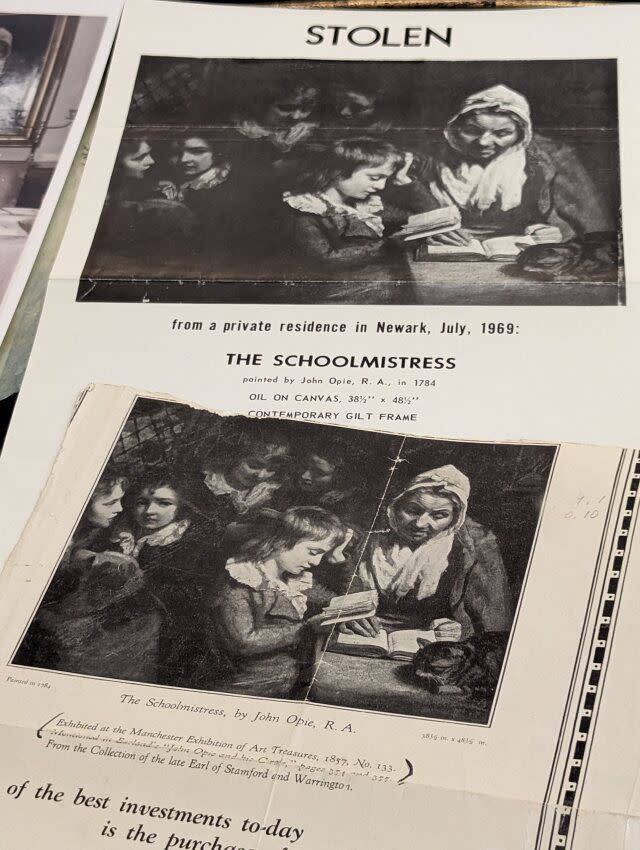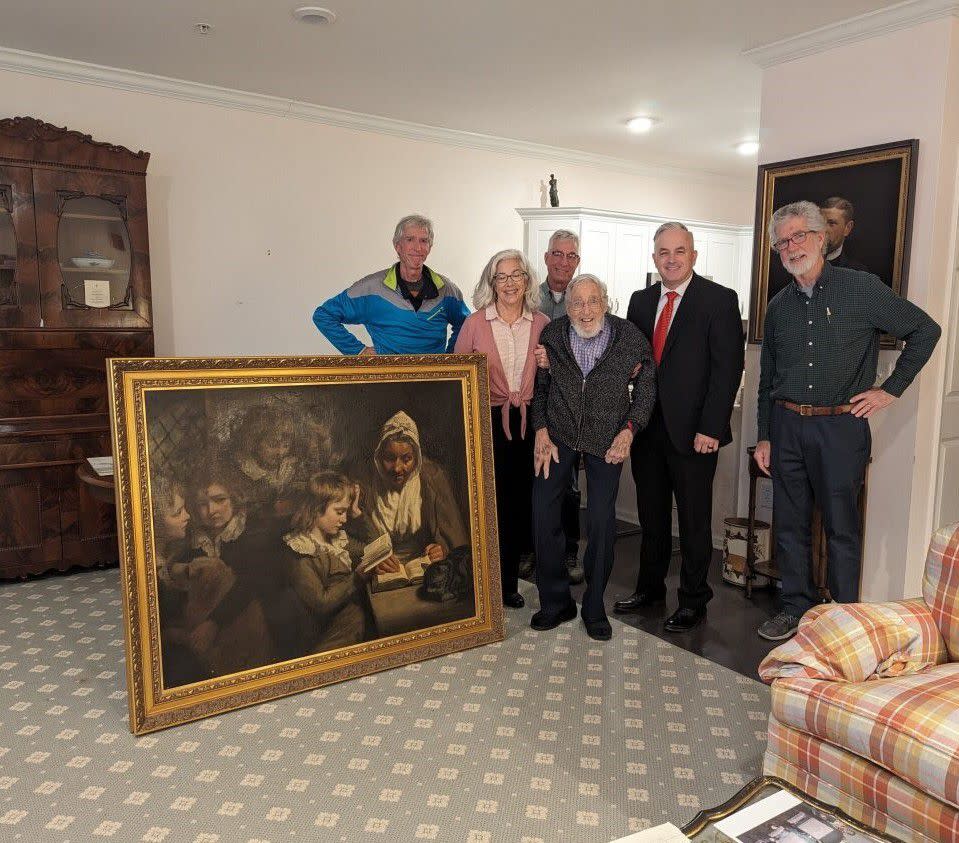An FBI agent’s journey to returning an 18th-century stolen painting back to a New Jersey family

- Oops!Something went wrong.Please try again later.
When FBI special agent Gary France caught wind of a stolen painting from the 18th-century, he was “a little skeptical” about the case. The art theft was said to have ties to organized crime in addition to its historic ties.
“I was born in 1971, so the idea of investigating the crime that occurred even before I was born was quite daunting,” France said in a media conference Friday.
The painting in question is called “The Schoolmistress” by John Opie and went missing from a private New Jersey residence after a July 25, 1969, burglary. It ended up with an accounting firm in Washington County, Utah, as the firm worked to liquidate the estate of a man named James R. Gullo.
“This piece of art, what a history it’s had,” France said. “It traveled all through the U.K. when it was first painted, and owned by quite a few families in the U.K. and then it travels overseas to the United States and is sold during the Great Depression. And then stolen by the mob and recovered by the FBI decades later. It’s quite amazing.”
France said he’s nearing retirement and the experience of working on this case was one of his top five best experiences on a case in his career.

The artist behind the work, Opie, was hobnobbing with the Blue Stockings Society — a literary circle attached to a broader women’s movement — and in tandem with his social connections, he made realistic portraits of iconic Enlightenment era figures like Mary Wollstonecraft and Edmund Burke. His portrait work, whether of famous or everyday people, was noted for its contrast between light and dark, as is apparent in “The Schoolmistress.”
Opie enjoyed success as an accomplished portrait artist during the late 1700s. He was similar to Rembrandt in his use of light and brushstrokes and was known for oil paintings in the style of realism. The first documented sale that emerged during the investigation occurred in 1788 and like other pieces of art, it passed through different people’s hands including a New Jersey man.
Earl Leroy Wood was drawn to “The Schoolmistress” during the Great Depression. He spent $7,500 on the painting in 1930. The original bill of sale indicated the painting came “from the collection of the late Earl of Stamford and Warrington.”
After Wood purchased the painting, there’s some correspondence that it indicates he shipped it over to Spink and Son for restoration and cleaning. That was in 1954 — 15 years before it was stolen.
Wood’s home was the target of a burglary attempt in July 1969, court documents say. Three men attempted to steal a coin collection, but were driven out by a burglary alarm. Then, that same month, the painting was stolen.
It wasn’t until June 1975 that there was an admission as to who carried out the burglary: Festa admitted to it in a trial testimony. During Festa’s testimony, he said that he and two other men carried out the art theft “under the direction of Senator Imperiale.” Festa testified that the painting was in the possession of Imperiale.
Imperiale never had any charges brought against him, court documents say.
“The criminal subjects were tied to the Castiglione crime ring,” an affidavit states. “It is believed that law enforcement pressure forced the painting to be transferred to another mobster.”

Two decades passed and then James R. Gullo purchased a Florida home with property from Rocchina Covello and the painting was included in the sale of the home. Gullo did not know about the painting’s history or where it had come from.
“When James R. Gullo purchased the Covello residence, Gullo indirectly became a good faith purchaser of the painting,” the affidavit says. “However, it appears that Gullo neither realized the painting was an original Opie, nor understood its potential history and value as such.”
A Covello family member, Joseph Covello Sr., was a reputed lieutenant of the Gambino crime family, court documents say.
“While no information was discovered during the investigation to unveil the painting’s location between 1969 and the late 1980’s, I believe the Opie painting remained in the hands of organized crime members, and traveled in interstate commerce, until finally being observed within the residence of Joseph Covello Sr.,” France wrote in the affidavit. “The fact that Joseph Covello Sr. was a convicted mobster, supports my belief that the painting remained in criminal hands for twenty years.”
Though Gullo was born in Buffalo, New York, he moved to Florida during his life and opened up different restaurants. The Spectrum reported that he opened The Choo Choo Train Bar and Restaurant in Broward County Florida. Eventually, he moved to St. George, Utah, with his wife Marie where he spent the rest of his days before passing away on Jan. 5, 2020.
It was after then that Kris Braunberger at Hinton Burdick accounting firm began the process of liquidating Gullo’s assets and called the FBI about the painting.
After a lengthy investigation, France hand-delivered the painting to the Wood family — to Earl Leroy Wood’s son Francis — on Jan. 11, 2024. It was an experience that France described as joyful.
“It was an honor playing a role in recovering a significant piece of art and culture and reuniting a family with its stolen heritage,” France said. “In a world where criminal investigations often leave scars, it was a rare joy to be part of a win-win case: a triumph for history, justice, and the Wood family.”


